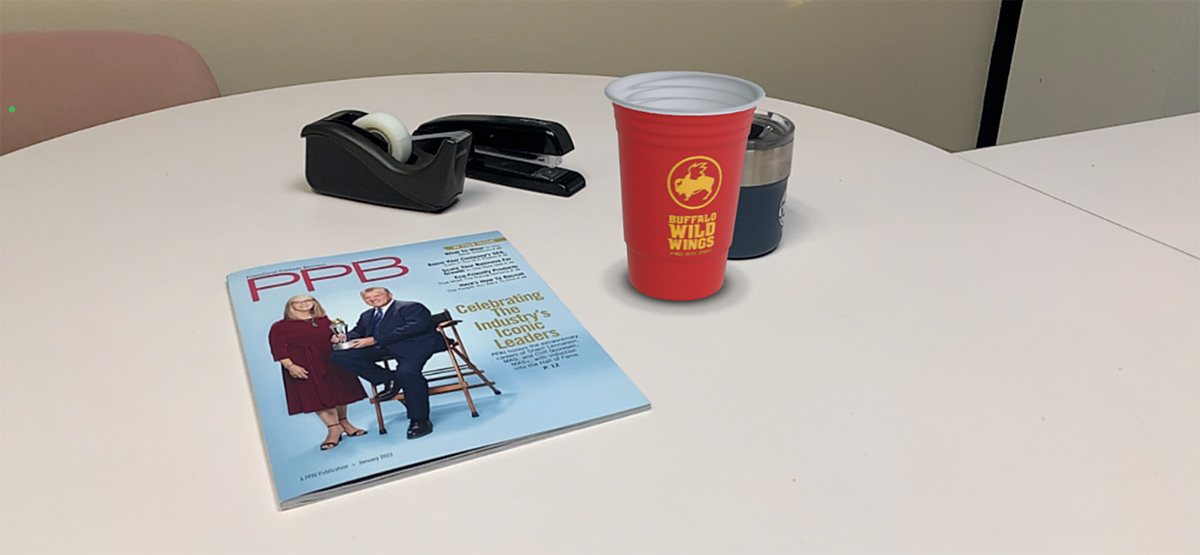Inside The Creation Of SnugZ USA’s New Augmented Reality Tool

The Buffalo Wild Wings labeled cup dances across a desk—on top of a book, next to some old papers—then jumps to the floor. Moving with the flick of a fingerprint or the slight cocking of the wrist, it is like magic or a vision of the future. The team who developed the augmented reality tool displaying the cup believes that future is now.
Swagar, announced by SnugZ USA (PPAI 112982, S11) in January, works similarly to the smartphone game Pokémon GO, try-it-on-virtually applications deployed by retailers such as Warby Parker, or even puppy dog filters often seen on social media stories. Looking through a smartphone’s camera, one can view a branded product in the ambient environment to get a feel for its size and quality when one is not on hand.
It’s not the first time a promotional products supplier has dabbled in augmented reality (AR), but SnugZ hopes it’s the tool that will stick.
 “I didn’t want it to come off as a marketing gimmick,” says Jeff Anderton, director of content for SnugZ, who led the creation of the tool. “This really has value and utility outside of the wow factor. We want this to be seen as a useful tool that can help in the actual doing of business to show that product better than you could before.
“I didn’t want it to come off as a marketing gimmick,” says Jeff Anderton, director of content for SnugZ, who led the creation of the tool. “This really has value and utility outside of the wow factor. We want this to be seen as a useful tool that can help in the actual doing of business to show that product better than you could before.
“I think at the end of the day, this will be a tool that we look back on and say ‘What did we do before this?’”
Swagar was demonstrated for distributors in Las Vegas at The PPAI Expo, Jan. 10-13. Products are available for display via the supplier’s online catalogue in true AR on smartphones or as moveable 3D displays when viewed on a desktop.
The tool’s initial rollout includes over 20 products, largely from SnugZ USA’s drinkware line, and the company plans to add more products and customization capabilities over time so that a distributor might be able to show a client how a logo will look on a product that is still being conceived.
The idea was kicked around at SnugZ’ West Jordan, Utah, headquarters for years, picking up steam as technology evolved even through the last year and the team modeled ways AR could be made applicable to branded merchandise.
 From the standpoint of SnugZ’ own brand within the promotional products industry, Vice President of Marketing Brandon Brown says it was important to be early to market in AR, even before it is widely used by the public, citing brand names like ChapStick or Kleenex that are synonymous with the products they sell.
From the standpoint of SnugZ’ own brand within the promotional products industry, Vice President of Marketing Brandon Brown says it was important to be early to market in AR, even before it is widely used by the public, citing brand names like ChapStick or Kleenex that are synonymous with the products they sell.
“Even though we may not have all of our bells and whistles rolled out right now, being first to market with these 20 or so products definitely gives us that part of it,” Brown says. “From a financial and ROI standpoint, those are always difficult questions. The ability for us to have this as a differentiator, to have this be another sales tool… to provide something that is a memorable experience, we’re going to eventually stand out in a crowded space.”
When the decision to go forward was made, SnugZ went to work building out the virtual “objects,” an intensive process that begins with creating digital 3D models and layering textures to make the products appear as photorealistic as possible. All of the virtual models are created in-house by Anderton.
“The culture of SnugZ, the creative freedom, the trust put into the marketing department, is the reason I’m here,” Anderton says. “They don’t just let us do it, but then they support it after the fact.”
Brown credits CEO Brandon Mackay, MAS, for creating a culture of risk-taking, with backup from Brittany David, MAS+, the chief revenue officer, as well as SnugZ’ sales team.
The release of Swagar is only one of SnugZ’ major plays recently; in December, it announced the acquisition of California-based Sweda Company (PPAI 113914, S11).
David says the decision to move forward with Swagar was shaped in large part by increasing digital uptake by consumers during the pandemic.
“COVID has opened the door for a lot more interactions virtually,” she says. “How do you get product or engage with people in an online platform when you’re not person to person? A big thing about our industry is touching and feeling samples or seeing the quality of materials. How can you try to replicate that so people can actually sample something virtually that isn’t through the normal lens of a website or a PDF? And what’s the cool factor?”
A major part of the appeal, David says, was to create a tool for SnugZ’ distributor customers, something they can use for their businesses to stand out in the minds of end buyers.
“It’s something different,” she says. “How do you make promotional products sexy and create an experience people are talking about? So far we consider it successful.”

